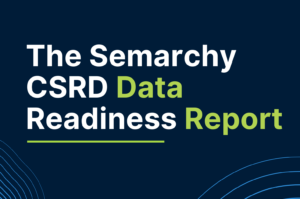The Corporate Sustainability Reporting Directive (CSRD) has raised the bar for corporate transparency. For the thousands of businesses it impacts, compliance is no longer just a regulatory checkbox — it’s a chance to demonstrate accountability on environmental, social, and governance (ESG) goals. But meeting these demands comes with profound challenges, especially when it comes to reporting on CSRD data with accuracy and consistency.
To better understand how businesses are tackling this, Semarchy conducted a survey of 1,000 senior data leaders, including Chief Data Officers, Chief Information Officers, and Heads of Data. We focused on French businesses and UK companies with significant EU operations, each generating over €200 million in annual revenue and operating for 15+ years.
Across industries such as finance, retail, government, and energy, our research offers insight into CSRD readiness, highlighting where companies stand today and what’s needed to close the gaps.

DOWNLOAD THE FREE REPORT NOW
What are the CSRD audit requirements?
The CSRD is transforming how businesses approach sustainability. Unlike its predecessor, the Non-Financial Reporting Directive (NFRD), it broadens the scope to include over 50,000 companies across the EU — significantly increasing the scale and complexity of reporting. Organizations must now meet CSRD audit requirements by disclosing their ESG impacts in granular detail.
Compliance with these audit requirements involves structured reporting against the European Sustainability Reporting Standards (ESRS). Companies are expected to provide insights into CSRD data points such as:
- Environmental impact
- Social responsibility
- Governance practices
- Resource use and circular economy
- Pollution
- Biodiversity
- Climate change mitigation and adaptation
- Employment and workforce matters
- Business conduct
For example, ESRS outlines an extensive dataset of 1,144 potential data points across sector-agnostic, sector-specific, and company-specific categories. One of the most critical aspects of the CSRD is the double materiality perspective — requiring businesses to assess both how sustainability issues impact them financially and how their activities affect society and the environment.
Understanding the CSRD implementation timeline
The implementation of CSRD will take place in phases, with key deadlines based on company size and scope:
- January 1, 2024: Large public-interest entities with over 500 employees (previously under the NFRD) must comply, with first reports due in 2025.
- January 1, 2025: Large companies not previously covered by the NFRD must comply, with first reports due in 2026.
- January 1, 2026: Listed small and medium enterprises (SMEs) must comply, with first reports due in 2027.
- January 1, 2028: Non-EU companies with significant EU operations must comply, with reports due in 2029.
With these deadlines approaching, businesses must act now to assess their CSRD readiness and build the systems necessary to meet audit and reporting standards.
Data management plays a pivotal role in achieving compliance. It’s not just about collecting data but ensuring it is accurate, auditable, and actionable.
With some disclosures requiring mandatory external audits, companies must put reliable solutions in place to consolidate, govern, and integrate data across their supply chains — often from disparate and siloed systems. Without strong data management strategies, ensuring CSRD readiness will be a nearly impossible task.
Are businesses ready for CSRD compliance?
The findings from Semarchy’s survey reveal a mixed picture of CSRD readiness across industries. While the vast majority of businesses (89%) have been collecting ESG data for at least a year, fewer than one in five (17%) say their data is currently audit-ready for CSRD compliance.
How long has your organization been collecting ESG data? |
|
| Less than 1 year | 7% |
| 1 to 2 years | 31% |
| 3 to 5 years | 44% |
| More than 5 years | 14% |
| We are not actively collecting and reporting on ESG data | 3% |
| Unsure | 1% |
This readiness gap reflects a broader issue: collecting data is not the same as being prepared for rigorous reporting and external audits. Even companies that have been collecting ESG data for more than three years report that becoming fully audit-ready might take 18 months or longer. This suggests that critical gaps in systems, frameworks, and governance remain unaddressed for many organizations.
How long do you expect it will take your organization to become CSRD audit-ready? |
|
| We are already audit-ready | 17% |
| Less than 6 months | 28% |
| Between 7 and 12 months | 37% |
| Between 13 and 18 months | 13% |
| More than 18 months | 4% |
| No clear timeline | 1% |
There’s also a lack of consistency in approaches to compliance: while 43% of respondents are adopting a phased rollout strategy, over a third are stalling due to perceived complexity or unclear guidelines. Around 30% of businesses are either “in no rush” to comply (20%) or are “monitoring developments” (11%).
What is your organization’s strategy for CSRD compliance? |
|
| Phased rollout approach | 43% |
| Moving quickly for full compliance | 23% |
| No rush | 20% |
| Monitoring developments | 11% |
| No immediate plans | 2% |
Planned IT spending to support CSRD data collection and compliance underlines potential inefficiencies. Although two-thirds of respondents intend to allocate over 10% of their IT budgets to CSRD compliance, this hints at overestimating the scale and complexity required. Establishing a robust data foundation doesn’t need to be a multimillion-dollar initiative.
In many cases, businesses already possess much of the data needed; the challenge lies in putting the right systems and governance frameworks in place to make this data accessible, high-quality, and reliable without excessive costs.
How much of your annual IT budget will be dedicated to supporting CSRD compliance? |
|
| Between 0 and 5% | 4% |
| Between 6 and 10% | 27% |
| Between 11 and 20% | 43% |
| Between 21 and 30% | 20% |
| More than 30% | 6% |
What are the key barriers to CSRD readiness?
For many businesses, the path from collecting ESG data to achieving CSRD audit requirements is fraught with obstacles, including:
1. Poor data quality
A critical barrier lies in data quality. Only 73% of businesses describe their ESG data as “high quality and reliable.”
That leaves nearly 30% struggling with issues around inconsistent, incomplete, or siloed ESG data management — problems compounded by similar challenges in financial, customer, and operational data. Without robust processes to unify and standardize data, meeting CSRD compliance is a steep task.
How would you describe the quality and reliability of your ESG data? |
|
| Very high | 36% |
| High | 37% |
| Moderate | 13% |
| Low | 8% |
| Very low | 5% |
| Unsure | 1% |
2. Lack of specialized data tools and infrastructure
The tools and infrastructure needed for CSRD data collection and reporting are also lacking. Just 27% of businesses surveyed have a centralized system for collecting and organizing siloed ESG data.
Similarly, fewer than 30% use robust solutions such as Master Data Management (MDM), audit trails, or real-time data integration — key systems that support the high level of governance and traceability demanded by CSRD audit requirements.
What data capabilities/infrastructure does your organization currently have in place to support CSRD compliance? |
|
| Centralized data management system | 27% |
| Audit trails and data traceability | 27% |
| Data quality monitoring | 27% |
| Automated data governance | 26% |
| Master Data Management (MDM) solutions | 26% |
| Real-time data integration | 25% |
3. Unclear roles and responsibilities
A surprising barrier lies in the lack of central accountability for compliance. While 68% of organizations rely on senior data executives — such as Chief Data Officers (CDOs) and Chief Information Officers (CIOs) — to lead their compliance efforts, this percentage is unexpectedly low, considering the critical role of data management in achieving CSRD readiness.
Moreover, only 33% of businesses cite Chief Financial Officer (CFO) involvement in the compliance process — a striking gap given the financial implications of non-compliance — while just 35% highlight leadership from Heads of Sustainability or ESG. This fragmented approach to accountability risks creating silos and inefficiencies, as successful compliance requires coordinated efforts across IT, finance, sustainability, and data teams.
Who is responsible for CSRD compliance in your organization? |
|
| Chief Data Officer (CDO) or equivalent | 58% |
| Chief Sustainability Officer (CSO) or equivalent | 35% |
| Chief Information Officer (CIO) or equivalent | 34% |
| Chief Financial Officer (CFO) or equivalent | 33% |
| Head of ESG or equivalent | 29% |
| Third-party consultants or service providers | 29% |
| Chief Executive Officer (CEO) | 29% |
What is the business value of CSRD data?
While the CSRD is widely seen as a regulatory obligation, Semarchy’s research highlights its potential as a driver of meaningful business outcomes. In fact, 61% of data leaders view compliance not as a burden but as an opportunity to drive innovation, efficiency, and trust — all key differentiators in today’s competitive market.
This is particularly relevant as many corporate ESG and DEI (Diversity, Equity, Inclusion) programs face being scaled back in the current economic climate. Against this backdrop, CSRD compliance is more than regulatory housekeeping — it’s a way to meet growing customer expectations, safeguard brand reputation, and improve operations.
For example:
- 44% of survey respondents see CSRD as a critical driver for product innovation.
- 43% view compliance as a means to strengthen their brand image.
- 36% of businesses anticipate reduced costs and improved efficiency.
How does your organization use, or plan to use, CSRD data to drive business value? |
|
| To meet customer demand for sustainable products and services | 44% |
| To improve brand reputation and trust | 43% |
| To enhance business relationships | 39% |
| To drive positive employee engagement and culture | 39% |
| To optimize operations and reduce costs | 36% |
Your blueprint for CSRD readiness
For many organizations, the CSRD challenge may feel overwhelming. Collecting, managing, and reporting on more than 1,000 sustainability-related data points — while ensuring accuracy and auditability — requires systems that few businesses currently have in place. However, at Semarchy, laying the foundation for trusted, reliable data is what we do best.
CSRD readiness isn’t about reinventing the wheel; it’s about applying proven data strategies to meet new requirements. This is “business as usual” for Semarchy. The Semarchy Data Platform empowers businesses to:
- Collect data in real time from internal systems, supply chains, and external sources with efficient data integration.
- Turn raw data into quality data through MDM solutions that ensure consistency, accuracy, and reliability — even for complex and siloed data sets.
- Keep data controlled and auditable using robust data governance frameworks and data intelligence solutions that create a single source of truth for all sustainability-related reporting needs.
With Semarchy’s solutions, businesses gain the scalability to adapt quickly to changing regulatory demands while avoiding excessive complexity or cost. Whether it’s unifying fragmented data or preparing data for auditing against CSRD compliance standards, Semarchy provides the tools to transform compliance from a perceived burden into a strategic advantage.
Download the full CSRD readiness report
Want deeper insights into how businesses are preparing for CSRD?
Download Semarchy’s full whitepaper for a detailed analysis of survey findings, practical strategies for achieving compliance, and how trusted data foundations can set you up for long-term success. Get access now to accelerate your CSRD readiness journey.
DOWNLOAD THE FREE REPORT NOW
Share this post
Featured Resources
No featured post selected.




















































